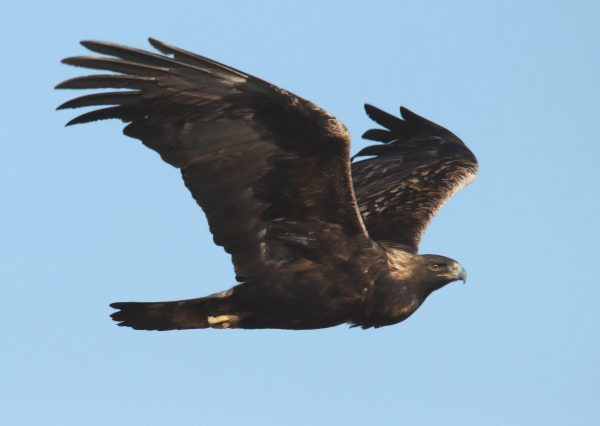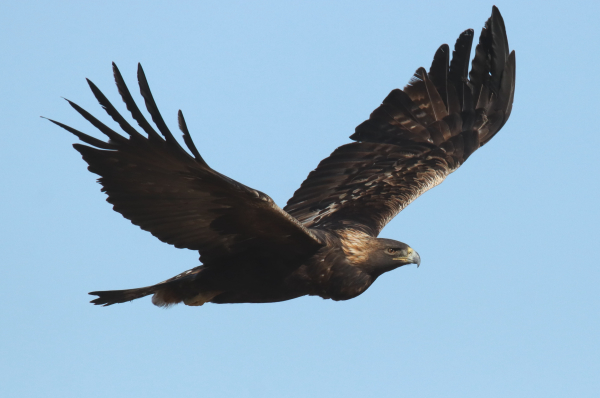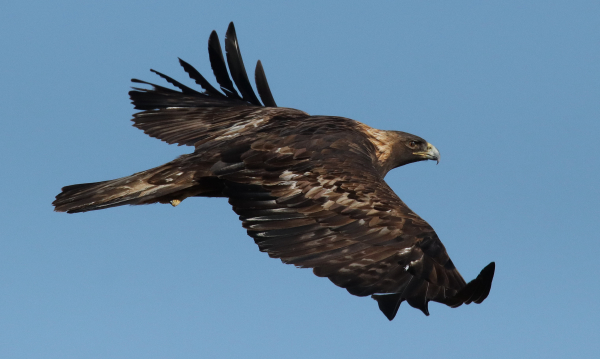Hope you like eagles – ‘cuz after chronicling last week’s series of Bald Eagle flight photos we’re featuring the 2 North American species back-to-back, and you guessed it, this week a wintering Golden Eagle is the featured subject. Photographed a week ago in a remote area of south-central South Dakota, an area where I’ve been thrilled by Goldens year after year with the closest encounters and most enjoyable interactions imaginable. I often just position myself close to the big raptors to spend time in their regal presence (but secretly waiting for their next action – camera at ready).

Last Wednesday I observed 4 Golden Eagles in the area, 1 hunting on the wing a distance away, 2 well-fed Goldens at separate hidden perches in the midst of small natural groves of tall cottonwood trees that overhang remote rural roads, and 1 hunting from a tall pole along an equally rural road. The latter 3 provided potential photo opportunities, but I made a poor judgement on one of them, I had a mechanical error on one and came up photo-less although the eagles were close in good light. But that leaves the story of the Golden Eagle that didn’t get away without being digitally documented.
Ten minutes before I found the eagle I was able to photograph, I was slowly driving down a little used road where I’ve seen Bald and Golden Eagles many times. In this case there was no indication of any birds among the mature leafless cottonwoods, but as I drove under large overhanging branches, an eagle suddenly materialized, perched on a less than obvious branch. It was essentially 10 feet ahead and 10 feet directly above the windshield, looking down at me, or at least staring at the white car driving below it. I gingerly kept driving and the eagle held its ground, or at least it held on to the branch, and I drove to a “T” in the road a short distance away and turned to the side so I had a clear view of the area with the sun behind me.

While my heart rate calmed and I thought about a next move, the Golden Eagle had its own agenda and suddenly flew from its cave of branches, flying west. I tried to focus on the eagle in flight, but all I could see through my viewfinder and lens was a blur in a blue sky. What the heck happened? As the eagle winged away, I checked my lens and saw that somehow I must have inadvertently rubbed a tiny switch at the lower end of the lens, thereby switching the lens from autofocus to manual focus – what?
Who uses manual focus anymore? Why is there such a switch in the first place on a modern lens created just 3 years ago? But ultimately, that kinda thing happens occasionally, unfortunately, and it was a missed opportunity. Even so, I could see this eagle was an immature by the white coloration in the center of each of its wings and along the base of its tail feathers, and I could also see it was well-fed by its bulging crop, which indicated the big raptor found a quiet place to rest and digest, until I bumbled along – ha.

Would I see another Golden in this area? I continued from the “T” in the road to the east, past where I observed and photographed an especially trusting adult Golden Eagle during my previous visit to the area a month before. There was no sign of a raptor on any of the regularly used perches in the area, but I was on high alert as I approached another grove of mature cottonwood trees. This was a location where I enjoyed my most memorable interaction with a Golden Eagle, an adult that flew out from the trees and circled low 3 times in brilliant winter sunlight, providing a series of my favorite images of the species – another “hoka hey” experience!
I slowly continued beneath the overhanging trees without a sign of another bird, but toward the far end I was doubly surprised by the sight of another Golden Eagle perched low on a branch beneath the canopy of large branches. This time I hit the brakes, although that probably wasn’t a good idea – but do I stop or drive by the big raptor, hoping it doesn’t flush as a result of either action? So there I was again, with a Golden Eagle perched 10 feet above me and 10 feet in front of the car. The eagle looked concerned, but didn’t move; and my instinct was to back up, which didn’t seem to affect the eagle either – phew. But now what?

I could barely see the eagle through the tangle of branches, much less photograph it. Hmm, the sun was to our right, in the south, so maybe my best bet would be to try to walk into the adjacent harvested cornfield to get into a position to photograph the eagle if it eventually left its perch. Maybe a rare truck, tractor, or UPS delivery truck would happen by and displace the eagle, or maybe it would decide to fly on its own. I walked in a quarter circle, keeping an eye on the eagle and my shadow I walked to reach my favorite photo position – with the sun at my back and my shadow pointing at a bird – in this case a large Golden Eagle.
In the process of walking across the muddy field, the soles of my shoes accumulated a thick cover of black mud, but never mind, there’s a spectacular Golden Eagle in sight. I stopped where there was a sizeable opening between the trees, where I envisioned I might be able to focus on the eagle if it took flight, and I would adjust my position from there in case it made a turn or circled. Then again, the eagle could fly low to the north behind the cover of the trees, and I’d be left with no chance of a photo, again. After checking my camera and lens settings at the car, I had a chance to do it again as I stood in the open, and about the time my lower back began aching a bit from my stationary position, I saw the eagle lean forward and mute, then take flight – which way would it fly?
Woo-whee, it winged into the blue sky opening in the trees before me, and headed southeast (to my right). I followed its flight through my lens, taking a series of photographs of the big Golden’s rather slow, steady wing beats – How Exciting! I continued to take photos as the eagle winged in front of the rest of the trees, and as it broke into the area beyond branches with more blue sky background. I appropriately yelled “Hoka Hey” as the grand eagle continued southbound. As I mentioned in last week’s Bird Photography feature, I like to share the Lakota call with abiding eagles – Golden and Bald. Hoka Hey is a native Lakota Sioux word for “Let’s do it,” or “Let’s go!” For me, it’s a historic call that I use to acknowledge an exciting opportunity to observe and photograph an eagle – usually something of a shared experience between me and an eagle.
That was the highlight of my day of searching for raptors along my SoDak winter raptor route, but I continued identifying and counting all the birds of prey and other species I see on a regular basis – usually once a month – since 2015 – 10 years now. This year numbers are low, perhaps owing to a lock of snow or available prey, but during the January 29th survey I observed 4 Golden Eagles, 5 Bald Eagles, 6 Rough-legged Hawks, 8 Red-tailed Hawks, and 1 Ferruginous Hawk for a total of 24 raptors. It was my lowest count ever, but it was exhilarating nonetheless, and the chance to photograph representative birds of each of these species made it a special day afield indeed. But this day will be remembered for the chance to photograph an adult Golden Eagle as it flew across a clear blue sky on a spring-like January day – hoka hey!
Article and Photographs by Paul Konrad
Share your bird photos and birding experiences at editorstbw2@gmail.com